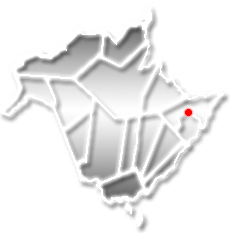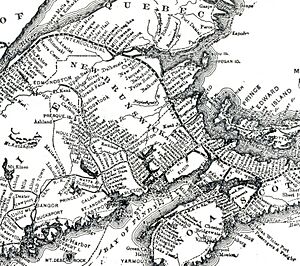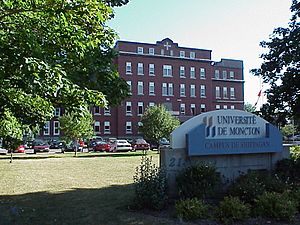History of Moncton facts for kids
The history of Moncton goes back thousands of years. The first people to live here were First Nations groups, like the Mi'kmaq. Moncton is a city in New Brunswick. Its motto is Resurgo, which means I rise again in Latin. This motto was chosen in 1875. It celebrated the city's comeback after the shipbuilding industry faced big problems.
Moncton lived up to its motto again later. In the 1980s, the city's economy struggled. Big employers like the CN repair shops and Eaton's left. But Moncton bounced back! It grew in areas like light manufacturing, technology, and tourism. Today, it's the fastest-growing city in Canada east of Toronto.
Contents
- Early People: The Mi'kmaq
- French Settlers: The Acadians
- New Settlers: From Pennsylvania
- Growing Slowly: Early 1800s
- Becoming a Town: First Incorporation
- Hard Times and a New Start
- Growing Stronger: Second Incorporation
- Acadian "Renaissance"
- Another Downturn
- "Moncton Miracle"
- Recent Events
- A Difficult Event in 2014
- See also
- Images for kids
Early People: The Mi'kmaq
The first people to live in the Petitcodiac river valley were the Mi'kmaq. Moncton is located at the end of an old native travel route. This route connected the Petitcodiac River to Shediac Bay. Shediac Bay is on the nearby Northumberland Strait.
French Settlers: The Acadians

French Acadians first settled near the Bay of Fundy in the 1670s. They slowly moved west over the years. The first mention of the "Petcoucoyer River" was in 1686. The Chipodie Acadian settlement started in 1700.
Settlers then moved up the Petitcodiac and Memramcook River valleys. They reached the area of Moncton in 1733. The first Acadian settlers in Moncton created a farming community. They called it Le Coude, which means The Elbow.
In 1755, the British took control of the Petitcodiac River valley. This happened after they captured Fort Beauséjour. The British forced the Acadian people to leave the area. This event is known as the Expulsion of the Acadians.
Some Acadians from the Petitcodiac and Memramcook valleys escaped. They hid in the woods. Led by Joseph Broussard, they fought against the British. The Acadian settlement of Le Coude was empty after this time.
New Settlers: From Pennsylvania
In 1766, Captain John Hall arrived from Pennsylvania. He had a special land grant. Eight families from Pennsylvania came with him. These families were called "Deutsch" settlers. They included families like Steeves, Trites, and Somers.
They named their new home The Bend of the Petitcodiac, or simply The Bend. There is a plaque in their honor at Hall's Creek. One old building from this time still stands. It's called the "Treitz Haus." It was built in the early 1770s. Today, it's a tourist information center.
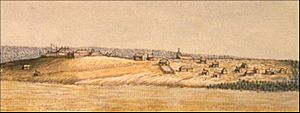
The American Revolution did not affect The Bend much. The Deutsch settlers were focused on their new lives. They were not interested in the revolution. However, there was an attack on nearby Fort Cumberland in 1776. This attack was led by Jonathan Eddy. It was meant to encourage Nova Scotia to join the revolution. The attack failed when British soldiers arrived.
Growing Slowly: Early 1800s
The Bend started as a farming community. It grew very slowly for about 75 years. It was smaller than nearby towns like Sackville and Shediac. In 1788, only 12 families lived there. By 1836, there were only 20 households.
Things started to change around this time. Travel and communication were mostly by sea. Roads were not very good. But in 1836, the Westmorland Road became usable all year. This allowed regular mail and stagecoach service. The Bend was a good place for a stop and transfer point. This helped the community grow.
Logging became important to the local economy by the 1840s. Later that decade, Joseph Salter arrived. He built a large shipyard at The Bend. Soon, over 1000 people worked at the shipyard. The quiet community of The Bend began to change. It developed services to support the shipyard. A bank, the Westmorland Bank, also opened. This bank helped fund more shipbuilding.
Becoming a Town: First Incorporation
The success of wooden shipbuilding helped The Bend become a town. It was named Moncton in 1855. The first mayor was Joseph Salter. The town was named after Lt. Col. Robert Monckton. He was the British commander who captured Fort Beauséjour. A mistake when the town was named led to the spelling "Moncton."
Two years later, in 1857, the European and North American Railway opened. It connected Moncton to Shediac. Then, in 1859, a line opened to Saint John. At first, the railway did not have a big impact on Moncton. The railway's main office was in Shediac.
Hard Times and a New Start
Around the time the railway arrived, steam-powered ships became popular. This meant the end of wooden shipbuilding. This caused a big economic problem for Moncton. The Westmorland Bank also went bankrupt. Because of these problems, Moncton gave up its town status in 1862.
But Moncton's economic problems did not last long. In 1871, the city got a new chance. Moncton was chosen to be the main office for the Intercolonial Railway of Canada. This railway combined other lines. Moncton became a central hub for the railway.
New railway lines were built from Moncton. One went to Truro and Halifax. Another went north to Newcastle and into Quebec. This made Moncton the most important economic center for northern New Brunswick. The railway became a huge part of Moncton's history for the next 120 years.
Growing Stronger: Second Incorporation
With the Intercolonial Railroad, Moncton became a town again in 1875. This is when it adopted the motto "Resurgo" (I rise again). One year later, the railway line to Quebec opened. The railway brought many jobs. This growth helped Moncton become a city on April 23, 1890.
In 1906, a large fire happened at the railway yard. People worried the railway shops might move to Halifax. But Henry Robert Emmerson, a Moncton native, helped. He was a government minister. He asked the Prime Minister to rebuild and expand the shops. His efforts worked! A larger shop was built, saving the city's future.
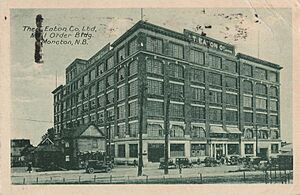
Moncton grew quickly in the early 1900s. In 1912, it became the eastern end of the National Transcontinental Railway. This line connected Moncton to Quebec City and even to Winnipeg. The First World War stopped railway expansion. But Moncton became important for moving supplies to the port of Halifax.
In 1918, the Intercolonial Railway became part of the new Canadian National Railways (CNR). The Moncton shops became CNR's main repair facility for the Maritimes. Moncton also became the headquarters for CNR's Maritime division.
Because Moncton was a key railway and shipping hub, the T. Eaton Company built a large catalogue warehouse here in the 1920s. It employed over 500 people. Other businesses like meat packing and light manufacturing also grew.
As Moncton grew, more people moved there. Many were French-Acadians from the surrounding areas. They were descendants of those who returned after the 1755 expulsion. For 150 years, Moncton was mostly English-speaking. But in the early 1900s, many Acadians came for jobs. This led to a big change in the city's population and culture.
Moncton continued to be a key distribution and transportation center during the Second World War. The Royal Canadian Air Force built two air bases nearby. The Canadian Army also built a large supply base near the railway. This base helped sort supplies for ports like Halifax and Saint John.
After the war, the air base at Moncton became a civilian airport. The other base became an industrial park. The army continued to use its supply base (CFB Moncton).
Railway jobs in Moncton reached about 6,000 workers during the steam locomotive era. But after World War II, this number began to drop. New diesel locomotives needed fewer workers.
Roads around the city expanded in the 1950s. The CNR also built a large railway yard in the city's west end. The old downtown railway yard was changed. The historic passenger station was replaced with a smaller, modern one. A shopping center, Highfield Square, and office buildings were also built.
Moncton became part of the Trans-Canada Highway network in the early 1960s. Route 2 was built around the city. Later, Route 15 connected Moncton to Shediac. At this time, the Petitcodiac River Causeway was also built.
Acadian "Renaissance"
The Université de Moncton was founded in 1963. This started an Acadian "renaissance," or rebirth. University teachers helped encourage this. The university and new government programs led to more demands for French services. This caused some tension between French and English speakers in the 1960s and 1970s.
The Acadian population became more successful in the 1980s. Tensions about language began to ease. English speakers generally accepted the idea of bilingualism. Many students started taking French Immersion classes. Being bilingual became one of Moncton's strengths.
Another Downturn
The late 1970s and 1980s brought hard times again. Several major employers closed or changed. The Eatons catalogue division closed in 1976. CN closed its locomotive shops in 1988. Thousands lost their jobs. The government had to step in to help Moncton's economy. CFB Moncton also closed around this time. Moncton's slogan even became "Moncton - We're OK."
"Moncton Miracle"
In the early 1990s, Moncton's economy changed. Information technology grew, especially call centres. These call centers used the city's bilingual workforce. Being bilingual was promoted to attract these jobs. They were a temporary help as Moncton changed its economy.
By the late 1990s, retail, manufacturing, and services grew. Within ten years of the CN shops closing, Moncton had gained back all its lost jobs. This amazing comeback is called the "Moncton Miracle."
Recent Events
In 1998, Prime Minister Jean Chrétien chose Moncton to host the Francophonie Summit in 1999. This was a big meeting of French-speaking nations. Moncton was chosen partly because Acadians see it as their "capital." The summit was the largest conference ever held in the city. Leaders and groups from 54 nations attended.
After the World Trade Center attacks in 2001, flights were stopped in the United States. Over a dozen planes with about 2,500 passengers were sent to the Greater Moncton International Airport. This was part of Operation Yellow Ribbon. The Moncton Coliseum became a temporary shelter. But the people of Moncton welcomed the stranded passengers. Many opened their homes to them. Later, a road near the Coliseum was renamed "September 11 Ave."
Moncton has continued to grow since the 1990s. The city has hosted big events. These include the Francophonie Summit in 1999, a Rolling Stones concert in 2005, and the Memorial Cup in 2006.
Other positive changes include Atlantic Baptist University becoming a full university. It moved to a new campus in 1996. The Greater Moncton International Airport opened a new terminal in 2002. It became an international airport. The new Gunningsville Bridge opened in 2005. In 2002, Moncton became Canada's first officially bilingual city. In 2006, Moncton became the largest metropolitan area in New Brunswick.
A Difficult Event in 2014
On June 4, 2014, a difficult event occurred in Moncton. This led to a large community response. The Pinehurst Park area was locked down. Residents were asked to stay in their homes. Public transportation was stopped. Schools, offices, and businesses were closed. The community came together during this time.
See also
- History of New Brunswick
- List of entertainment events in Greater Moncton
- List of historic places in Moncton
- Timeline of Moncton history
Images for kids


